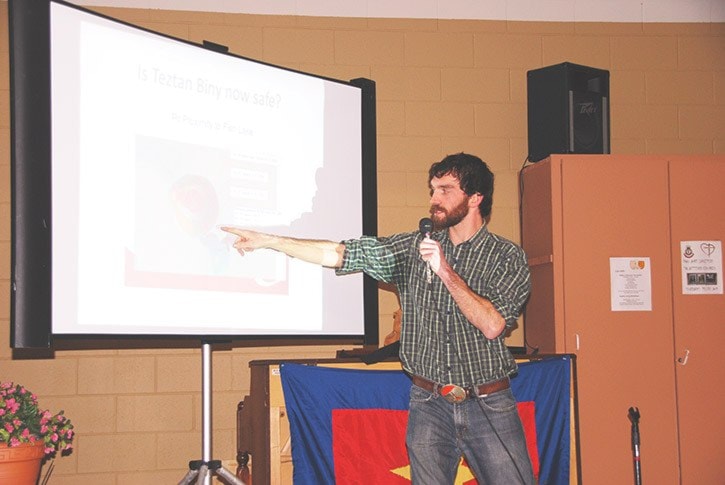The Tsilhqot’in have been protecting their land since before contact, says Xeni Gwet’in Chief Marilyn Baptiste.
“Our people have shown that throughout our history. As many of you know, in the Tsilhqot’in War of 1864, our warriors stopped the road coming in on the west side of our territory,” Baptiste said during the Fish Lake Alliance’s public meeting on the New Prosperity Mine project held at the Salvation Army hall in Williams Lake, Jan. 31.
“Back then they were after gold, again they’re after gold, this time in the Fish Lake area,” Baptiste continued.
She said it was a win for her people when the first Prosperity mine proposal was rejected so it’s unfortunate they are having to go through the process again for the new proposal.
“One of the more than 50 deficiencies identified in the project’s environmental impact statement is on the project’s impact on Aboriginal rights, our use of that land, and our fishing,” Baptiste said.
Yunesit’in Chief Russell Myers Ross said another go-around with the environmental review of New Prosperity mine proposal is similar to being in an Avatar sequel.
“The issue is a matter of justice,” Ross said. “It’s still a question of who owns the land. There was no time that the Tsilhqot’in ever gave up the land.”
J.P. Laplante, mining manager for the Tsilhqot’in National Government, said the new proposal is “completely unacceptable” to the Tsilhqot’in.
During a slide presentation he said it is important to understand that the New Prosperity proposal isn’t new.
“It’s alternative number two. Under the federal environmental assessment you have to provide alternatives to your mine plan,” Laplante said. “This was their alternative and throughout the last hearings the Tsilhqot’in heard arguments about how it couldn’t really be done.”
He said the open pit will be within 500 metres of Fish Lake (Tetzan Bay), while the tailings pond, measuring three kilometres wide by four kilometres long, with a 35-story dam, will be located up stream of Fish Lake and will drown the Little Fish Lake area, which contains traditional harvesting territory and Aboriginal grave sites.
Critical of the water management plan for the mine, LaPlante described it as complicated at best, and that there are “serious” risks Fish Lake would lower, regardless of efforts to pump the water.
Quoting from Taseko’s own project description, he said spawning habitat at Fish Lake would be impacted.
“The company writes that currently a spawning population of approximately 15,000 fish use an available 12,000 square metres of available spawning habitat. It would be reasonable to expect that the 2,440 square metres that will be retained will be sufficient for a spawning population of approximately 1,400 pairs of fish.”
The number represents almost 82 per cent of the spawning habitat being destroyed, he added.
Another consideration is the impact the mine could have on the “viable” economy of the Chilcotin in-river salmon run.
“It’s an economy that could last forever if the salmon and their habitat are safe guarded.”
In 2010, the Fraser River Sockeye Salmon generated $60 million dollars to the commercial fishery.
“On average of the last 10 years, the Chilko River salmon run has represented 25 per cent of that Fraser River Sockeye run,” La Plante said. “This isn’t about economy or no economy, it’s about which economy and for how long.”
He encouraged people to attend the environmental review panel hearings and to consider speaking to the panel.
Brian Battison, Taseko’s vice-president of corporate and community affairs, told the Tribune during the environmental assessment Taseko will present the engineering and applied science which supports the development of New Prosperity.
“The project is sound, designed to protect the environment and to reflect and strengthen the community values important to the Cariboo.
“The plan is currently being examined by the federal review panel as well as by relevant federal departments,” Battison said.
He also encouraged members of the public to observe and participate in the process during the upcoming panel hearings.
“We acknowledge that there are different views in the community about the role, if any, this project should play in the future of the region.
We respect those views and will continue to provide factual information, answer questions and address concerns,” Battison said.
